The Saxophone Symposium is a scholarly, peer-reviewed journal devoted solely to the saxophone. A panel of professional performers, scholars, and pedagogues of the saxophone review all articles submitted for publication. Original, unpublished, research-based submissions in any category are welcome, including saxophone history, literature, pedagogy, jazz studies, contemporary practices, and interdisciplinary areas. Submitting materials for review, such as recordings, books, music, pedagogical materials, and other forms of media pertaining to the saxophone is also encouraged.
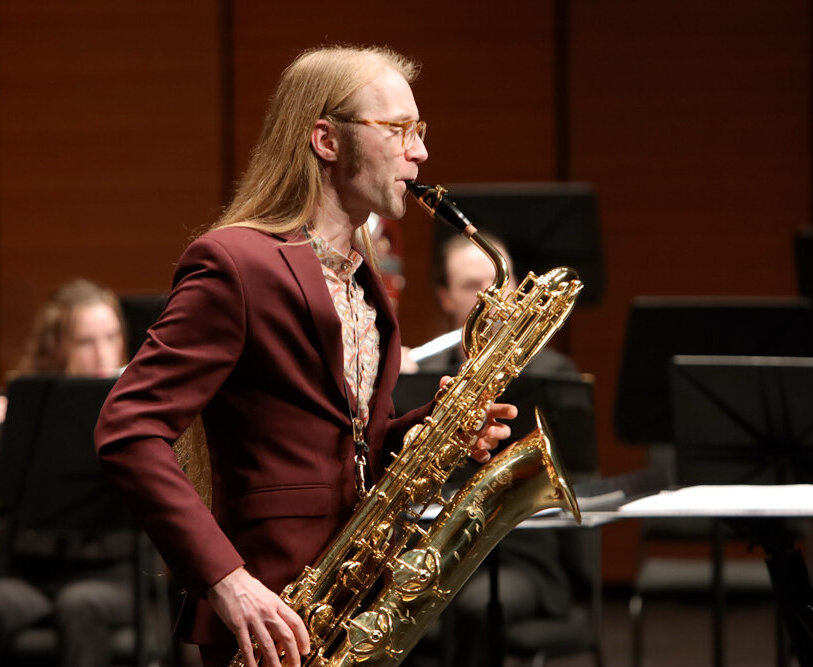
Current Issue
Volume 47
(Members Only) (54 MB) — Click here for a preview of this issue.- Articles
- Avian Melodies and Shepherds’ Brilliance: Lyricism, Virtuosity, and Pastoral Imagery in Eugène Bozza’s Improvisation et Caprice for Marcel Mule and the Paris Conservatoire, by Lacey Golaszewski
- The Use of Reflection in the Applied Undergraduate Saxophone Studio, by Nathan Mertens and Kelly Parkes
- George Theodos and His One-Handed Saxophones, by David Nabb
- A Historical and Analytical Study of Akira Yuyama’s Divertimento for Marimba and Alto Saxophone, by Jia-Yu Yang
- Sigurd Raschèr and Karel Husa: A Musical Partnership, by Andrew J. Allen
- Reviews
- Allison D. Adams and Brian R. Horner: Playing & Teaching the Saxophone: A Modern Approach, by Sarah Hetrick
- Assembly Quartet: RE(Mix), by Gabriel Piqué
- Kurt Bertels and Adrianne Honnold, editors: The Legacy of Elise Hall: Contemporary Perspectives on Gender and the Saxophone, by Julia Nolan
- Carolyn Braus, Molly Orlando, and Devree Lewis: Tale Still Told Andrew J. Allen
- Michael Dease: Swing Low, by Kevin Norton
- Kyle Horch and Anya Fadina: Inflorescence: Music of Moments and Places, by Andrew J. Allen
- William Horne, Walter Puyear, et al: Chamber Music of William Horne, Volume III, by Stephen Fischer
- Bryan Kendall: In Search of the Saxophone: Its Origins and Functions, by Kurt Bertels
- Joseph Lulloff and Yu-Lien The: New Stories, by James Kalyn
- Timothy McAllister and Liz Ames: Project Encore, Vol. 1, by Kevin Norton
- Curtis Peacock: Peacock’s Perfectly Complete Collection of All Possible Music Scales, by Stephen Fischer
- Heidi Radtke: Convergence, by Brandon Quarles
- Cecily Terhune and Carly Hood: Boon Bestowed, by Gabriel Piqué
- Matthew Younglove, Jeffrey Heisler, and Liz Ames: Night Set, by Brandon Quarle
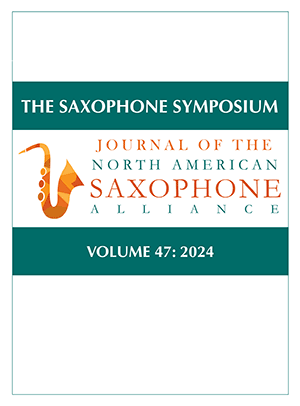
Manuscripts
Manuscripts should be submitted to the editor via email at the address listed below. Include a cover letter, which identifies yourself, shows the manuscript title, and certifies the manuscript as your own original work. The Saxophone Symposium will not consider any manuscripts that have been submitted simultaneously to another journal or that have been previously published elsewhere. Please note that submission length is limited to 8,000 words, inclusive of endnotes. In order to facilitate blind review, please remove your name, institutional affiliation, and any other identifying materials from the submitted paper.
Manuscripts should conform to the Chicago Manual of Style, 17th Edition. In addition to Chicago Manual requirements, authors must include an abstract (maximum length: 250 words) and up to five keywords describing the essential topic and content of the manuscript. Authors are responsible for obtaining permission for reproduction of musical examples from music publishers. Where appropriate, authors will be asked to provide proof of permissions from the appropriate authorities.
Please submit any questions about the review process, publication, and other concerns directly to the editor.
When submitting a manuscript, please include:
- A cover letter (including your name, the manuscript title, and a declaration of the originality of the manuscript)
- One copy of the manuscript with identifying information removed (your name, institutional affiliation, or any other identifying information should be removed before submission), in .doc or .docx format. Please use one-inch margins, double-spaced text, endnote citations, and Times New Roman font throughout.
- Attachment files for tables, figures, and musical examples (if applicable)
- Documentation of permissions for reproduction of musical examples from music publishers (if applicable)
- Authors of accepted manuscripts will also be required to submit a brief biography (maximum length: 250 words — please do not send unless requested)
Submitting Materials for Review Consideration
If you would like to have a published review of your CD, book, or other materials in the next Symposium, please review the following guidelines for submission:
- Send an email to the Coordinating Editor of Reviews, Adrianne Honnold, requesting to have your materials reviewed in the next available edition of the Symposium.
- In your email, include:
- A cover letter (including your name, email address, a statement indicating that you would like these materials reviewed for publication in The Saxophone Symposium, and a description of the material(s) for review)
- A copy of the material(s) for review, either as an attachment or a link
The Saxophone Symposium has a limited team of reviewers and receives many requests for reviews each year. Materials submitted for review consideration are not automatically accepted but will be approved based on the order received, the type of content, and the availability of external reviewers. Primary applicants may only submit one review request every two years. You will receive a confirmation email from the Coordinating Editor of Reviews if your materials are accepted for inclusion in the next journal issue.
NOTE: We have a team of pre-selected writers for reviewing materials, and thus The Saxophone Symposium does not accept unsolicited reviews.
To be considered for publication in the next issue, all materials must be submitted by December 15. Please send manuscripts to the Editor and materials for review to the Coordinating Editor of Reviews. Accepted articles and reviews will be published the following calendar year.
Advertising
The deadline for advertisements is March 1 of each calendar year. Advertisements will be included in that year’s edition of The Saxophone Symposium. Questions about advertising in The Saxophone Symposium should be directed to Nathan Mertens, NASA Director of Marketing and Development at marketing@saxophonealliance.org.
Saxophone Symposium Advertising Form (Due March 1) Saxophone Symposium
Back Issues
Members may access Volumes 43–47 (2020–2024) below. Additional back issues can be purchased from Groth Music.

Volume 47
(Members Only) (54 MB)Click here for a preview of this issue.
- Articles
- Avian Melodies and Shepherds’ Brilliance: Lyricism, Virtuosity, and Pastoral Imagery in Eugène Bozza’s Improvisation et Caprice for Marcel Mule and the Paris Conservatoire, by Lacey Golaszewski
- The Use of Reflection in the Applied Undergraduate Saxophone Studio, by Nathan Mertens and Kelly Parkes
- George Theodos and His One-Handed Saxophones, by David Nabb
- A Historical and Analytical Study of Akira Yuyama’s Divertimento for Marimba and Alto Saxophone, by Jia-Yu Yang
- Sigurd Raschèr and Karel Husa: A Musical Partnership, by Andrew J. Allen
- Reviews
- Allison D. Adams and Brian R. Horner: Playing & Teaching the Saxophone: A Modern Approach, by Sarah Hetrick
- Assembly Quartet: RE(Mix), by Gabriel Piqué
- Kurt Bertels and Adrianne Honnold, editors: The Legacy of Elise Hall: Contemporary Perspectives on Gender and the Saxophone, by Julia Nolan
- Carolyn Braus, Molly Orlando, and Devree Lewis: Tale Still Told Andrew J. Allen
- Michael Dease: Swing Low, by Kevin Norton
- Kyle Horch and Anya Fadina: Inflorescence: Music of Moments and Places, by Andrew J. Allen
- William Horne, Walter Puyear, et al: Chamber Music of William Horne, Volume III, by Stephen Fischer
- Bryan Kendall: In Search of the Saxophone: Its Origins and Functions, by Kurt Bertels
- Joseph Lulloff and Yu-Lien The: New Stories, by James Kalyn
- Timothy McAllister and Liz Ames: Project Encore, Vol. 1, by Kevin Norton
- Curtis Peacock: Peacock’s Perfectly Complete Collection of All Possible Music Scales, by Stephen Fischer
- Heidi Radtke: Convergence, by Brandon Quarles
- Cecily Terhune and Carly Hood: Boon Bestowed, by Gabriel Piqué
- Matthew Younglove, Jeffrey Heisler, and Liz Ames: Night Set, by Brandon Quarle
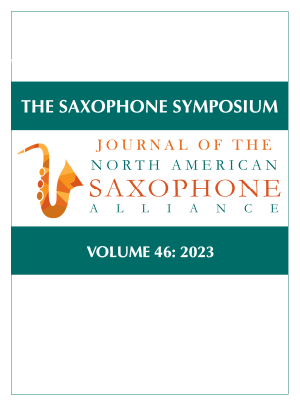
Volume 46
- Articles
- Attuned to the “Saxophone Lady”: The origin of Vincent d’Indy’s Choral Varié, by Kurt Bertels
- The Heifetz of the Saxophone: Chester Hazlett as Transitional Professional, by Andrew J. Allen
- Charles Jean-Baptiste Soualle’s Introduction of the Saxophone to Australia, by Nessyah Buder Gallagher
- Laurence Wyman’s Contributions to Saxophone Pedagogy and Literature, by Brian Kauth
- Harmonic Substitution and Reharmonization in Selected Compositions and Arrangements of Jerry Bergonzi, by Ben Nichols
- Reviews
- Geoffrey Deibel: Ex Uno Plures, by Andrew J. Allen
- Duo Aurous: Alchemy, by Kevin Norton
- h2 Quartet: Infinity Mirror, by Andrew J. Allen
- Don-Paul Kahl: Go Within, by Stephen Fischer
- The Daniel Pelton Collective: The Gold Coin Sessions, by Brandon Quarles
- Quasar Saxophone Quartet: Disque Bleu, by James Kalyn
- Debra Richtmeyer with Connie Frigo: The Richtmeyer Method for Saxophone Mastery, by Julia Nolan
- Julian Velasco: As We Are, by Stephen Fischer
- Dylan Ward: Tourmaline, by James Kalyn
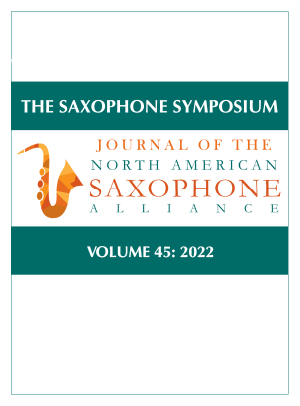
Volume 45
- Articles
- List of Featured Concerto Performers at North American Saxophone Alliance Biennial Conferences, 1994–2020, by Shawna Pennock
- Asenath Mann: Boston’s Gilded-Age Saxophonist, by Thomas Smialek and L. A. Logrande
- Zechariah Goh and the Development of Classical Saxophone in Singapore, by Leslie Wong and Rattanai Bampenyou
- Mrs. B. L. Hackenberger: Bessie Mecklem as Progressive-Era Clubwoman, by Thomas Smialek and L. A. Logrande
- Elise Hall in Santa Barbara (1889–1898): The Amateur Musical Club and Philharmonic Society, by James Russell Noyes
- “Another American Voice” – William Grant Still and the Saxophone, by Andrew J. Allen
- The Manuscript to Jacques Ibert’s Concertino da Camera: What We Can Learn from It, by Daniel Gordon
- Reviews
- Steven Bryant: In This Broad Earth, by Andrew J. Allen
- Rick Hirsch: Yuletide Improvisations, by James Kalyn
- Kyle Horch: Fairy Tales: Recital Music from Eastern Europe, by Andrew J. Allen
- Jonathan Hulting-Cohen: Second Flight, by Andrew J. Allen
- Mark Kilstofte: Inner Voices, for Bb or Eb saxophone solo, by James Kalyn
- Emily Koh: [word]plays—Microtonal Works for Saxophone(s), by Andrew J. Allen
- Opinion
- Marco Albonetti: Amarcord d’un Tango, by Carrie Koffman
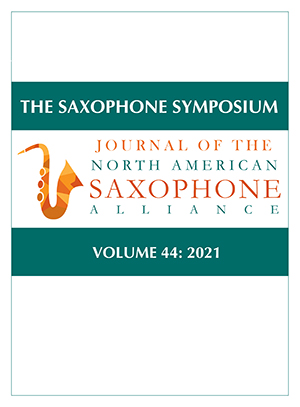
Volume 44
- Articles
- Improving the Quality of Saxophone Quartet Rehearsals: Interviews with Members of Kenari, h2, Sinta, and Fuego Quartets, by Benjamin MacDonald
- The Red Saxophone: Hanns Eisler and ‘Applied Music’ in Weimar Berlin, by Andrew J. Allen
- Gender Representation at North American Saxophone Alliance Biennial Conferences from 2008 through 2020, by Kimberly Goddard Loeffert
- The Raschèrian Approach: Cultivating the Elastic Bow of Articulation, by Andrew R. Steinberg
- John Sampen: Biography of an American Saxophone Pioneer, by Matthew Younglove
- Reviews
- Randall Hall, Oracle, by Andrew J. Allen
- Derek Brown, All Figured Out, by Andrew J. Allen
- Sean Murphy, Rediscovering Bauzin, by Andrew J. Allen
- Patchwork Duo, Patchwork, by Stephen Fischer
- Roberto Milano, Cuatro Concertinos, by Stephen Fischer
- Stallmann Duke Duo, Passing Through, by James Kalyn
- Lyle Rebbek, A Practical Guide for Teaching the Saxophone to Beginners, by Julia Nolan

Volume 43
- Articles
- The Role of Peter Clinch and Clive Amadio in the Creation and Dissemination of Original Concert Saxophone Repertoire in Australia, by Nessyah Buder Gallagher
- Lingual Exposé: An Ultrasonographic Observation of Saxophonists’ Tongue Positions While Producing Front F Pitch Bends, by Ryan C. LeMoine
- Eugene Coffin: The Making of a Nineteenth-Century Saxophonist, by Thomas Smialek and L. A. Logrande
- Eric Wubbels: A Biographical Sketch and Analysis of This is This is This is for two Alto Saxophones and Piano, by Matthew Younglove
- The Nineteenth-Century Brussels Saxophone School, by Kurt Bertels and Kristin Van den Buys
- The Raschèrian Approach: Recontextualizing the Saxophone’s Upper Register, by Andrew R. Steinberg
- Reviews
- Admiral Launch Duo, Launch, by Andrew J. Allen
- Mark Watkins, From the Inside Out: An In-Depth Resource for the Development of Saxophone Sound, by Andrew J. Allen
- Matthew Tracey and Yu-Ling Chen, Fantasy Pieces: The Music of Robert Schumann, by James Kalyn
- Dave Camwell, Second Wind, by Stephen Fischer
- Capitol Quartet with Hannah Creviston and Jun Okada, Mark Lanz Weiser: music for saxophone, by Julia Nolan
Corrections
Corrections from past issues of The Saxophone Symposium.
- Correction to Nestler (2017), p. 18
In the Psychological Considerations section, the article erroneously stated that Lars Mlekusch had “overcome dystonia.” While Mlekusch maintains an active career as a teacher and masterclass clinician, he has not fully recovered his ability to perform, and thus has not overcome dystonia.